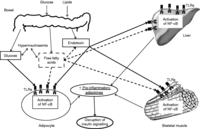Adipokine inflammation and insulin resistance: the role of glucose, lipids and endotoxin
- 1Division of Metabolic and Vascular Health, Clinical Sciences Research Laboratories, Warwick Medical School, University Hospital Site, University of Warwick, Coventry
CV2 2DX, UK
2Warwickshire Institute for the Study of Diabetes, Endocrinology and Metabolism, University Hospitals Coventry and Warwickshire NHS Trust, Walsgrave, Coventry CV2 2DX, UK
- (Correspondence should be addressed to M K Piya; Email: m.k.piya{at}warwick.ac.uk)
-
Figure 1
Overview of the effect of glucose, lipids and endotoxins on inflammation in the adipocyte, liver and skeletal muscle. Dietary glucose and lipids result in absorption of glucose, free fatty acids and leakage of endotoxins into the systemic circulation. Glucose activates NF-κB in the adipocytes via TLR activation, whereas free fatty acids and endotoxins activate NF-κB in the adipocytes, liver and skeletal muscle via TLR activation. Increased glucose results in hyperinsulinaemia, which in turn can result in an increased level of free fatty acids. Free fatty acids also have a role in increasing the endotoxin levels. Activation of NF-κB leads to release of pro-inflammatory adipokines from the adipocytes, liver and muscle, which in turn leads to disruption in insulin signalling in all three tissues, leading to insulin resistance.
- © 2013 Society for Endocrinology














